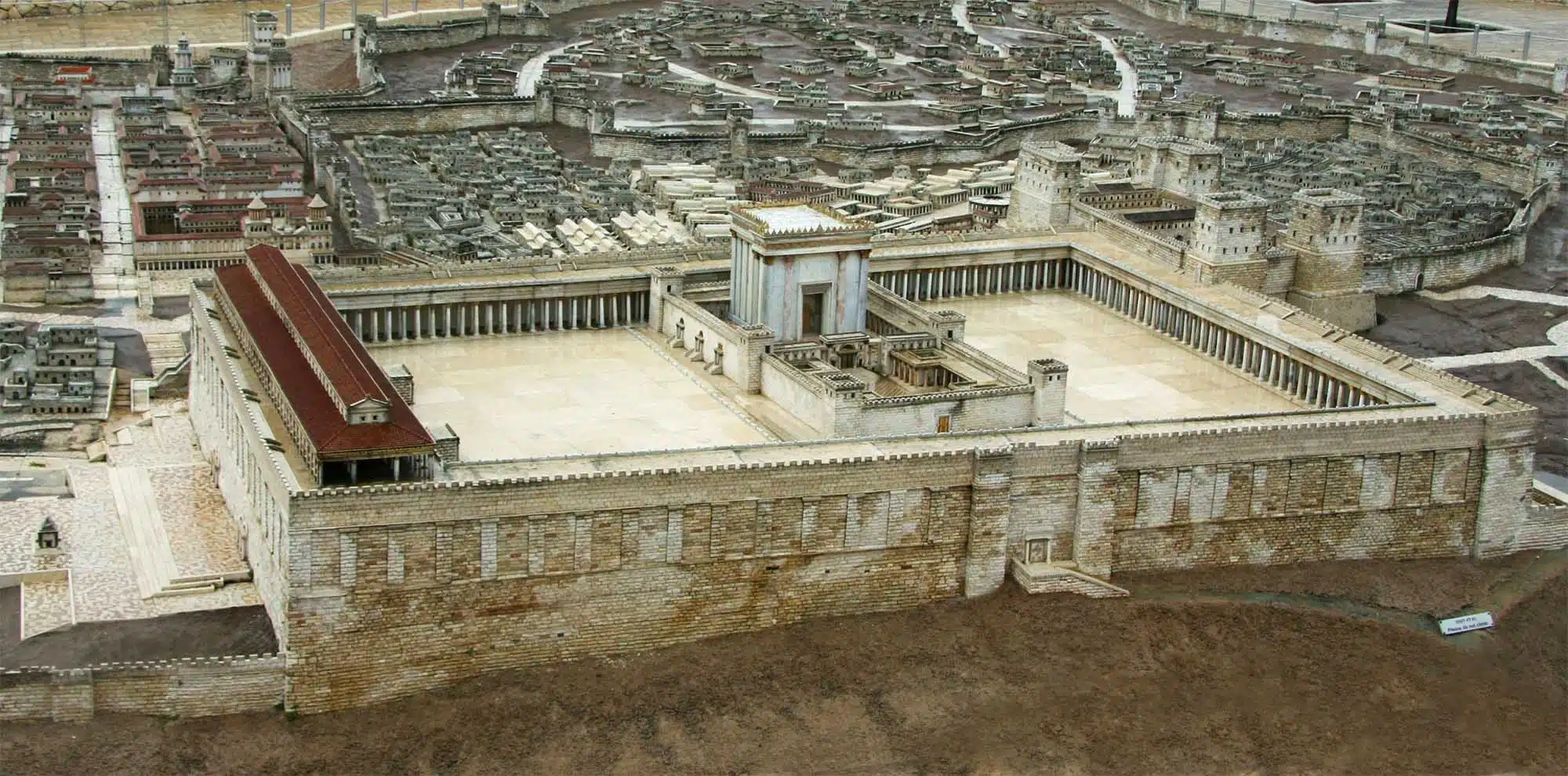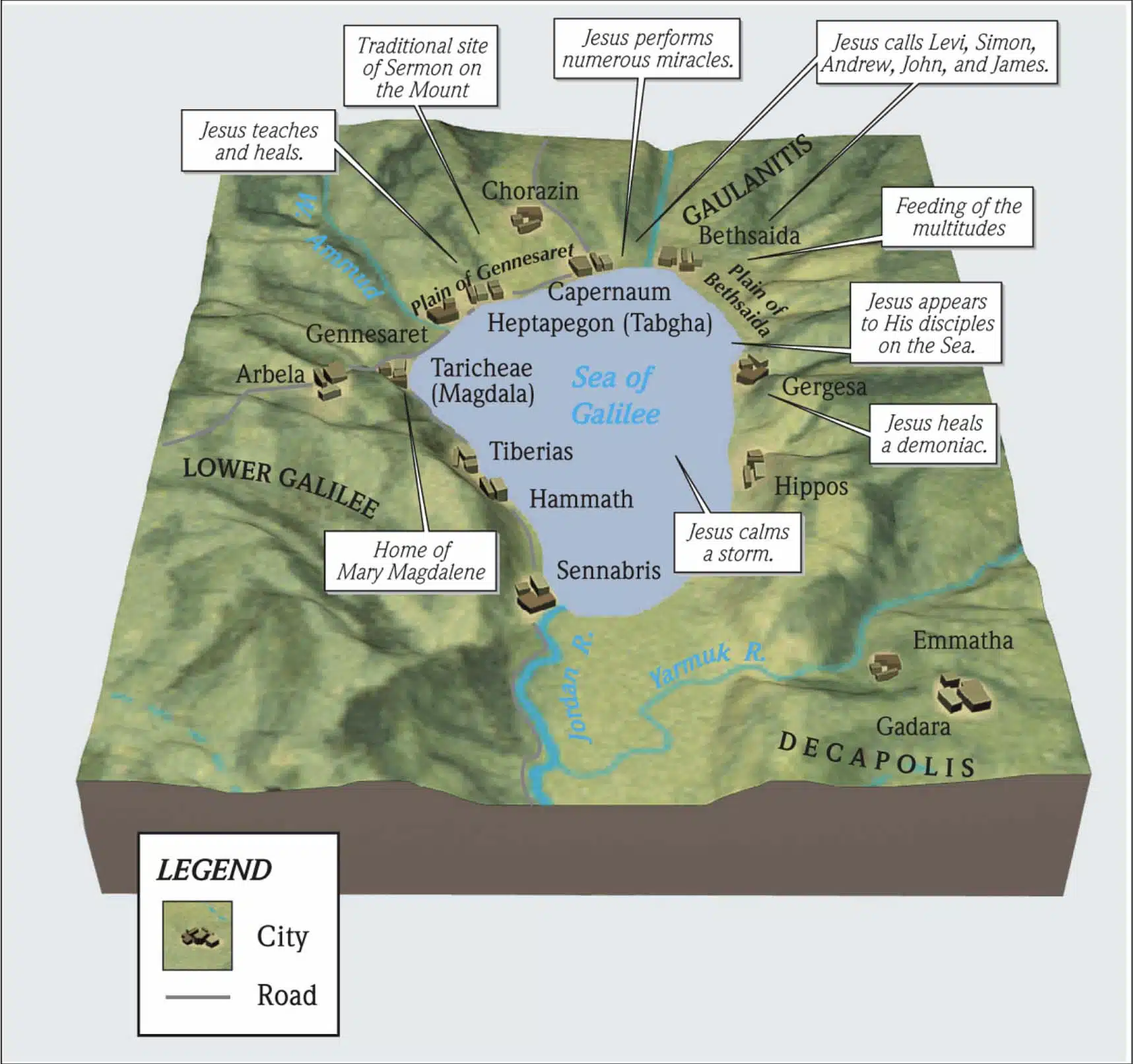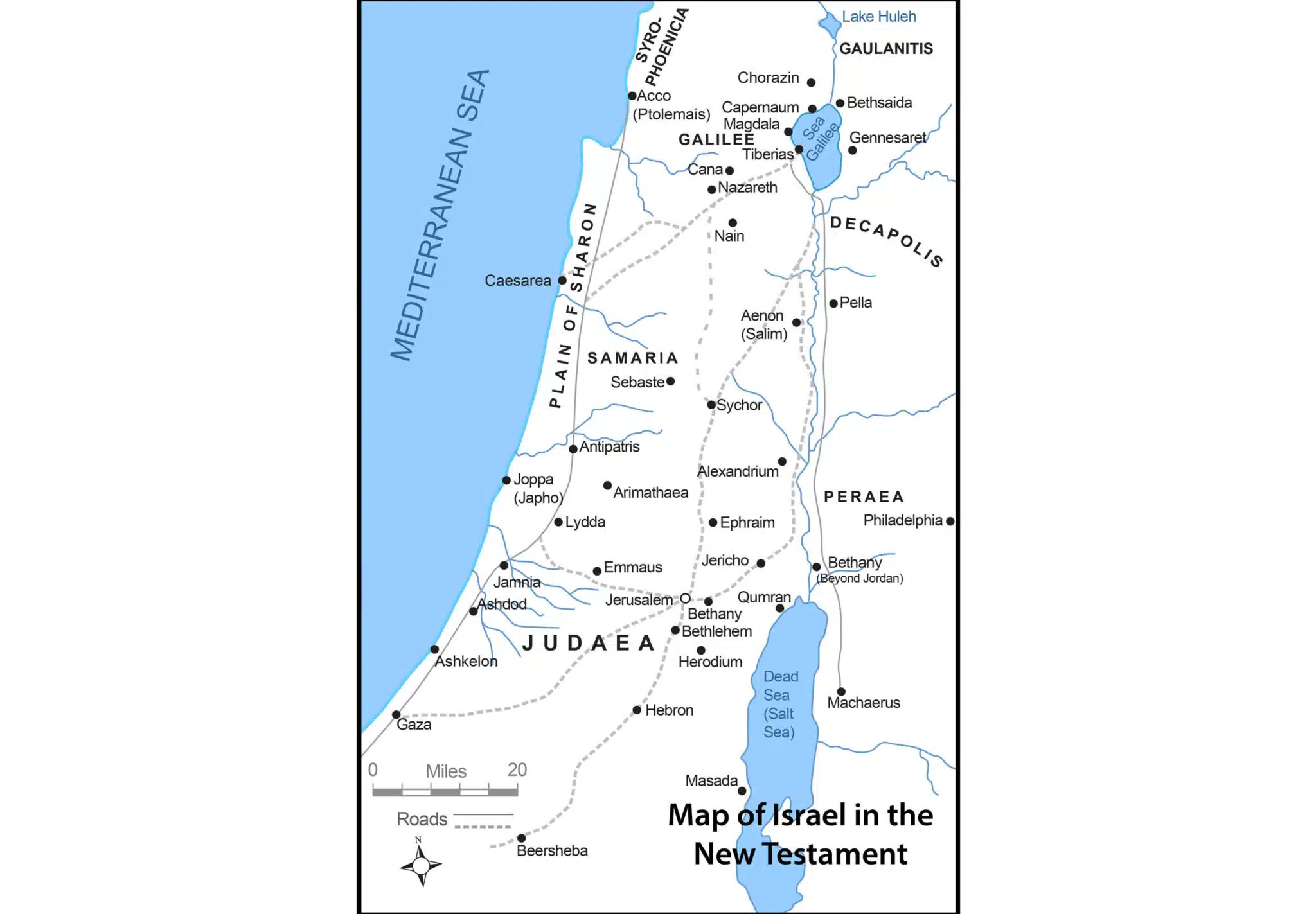Matthew begins his record of Jesus’s Olivet Discourse. As Jesus and His disciples leave the temple He tells them that it will be destroyed. This causes the disciples to ask three questions concerning future events. Jesus will answer the questions in the verses that follow.
The parallel gospel account of this event is found in Mark 13:1-4 and Luke 21:5-7.
This chapter begins Matthew’s fifth and final record of Jesus’s discourses. It extends through chapter 24 and 25 and is called “The Olivet Discourse.” The previous four discourses in Matthew were “The Sermon on the Mount” (Matthew 5:3-7:27), “The Missionary Discourse” (Matthew 10:5-10:42), “The Parabolic Discourse” (Matthew 13:1-35), and “The Discourse on the Church” (Matthew 18). Matthew 24-25 is called “The Olivet Discourse” because Jesus delivered it to His disciples as He was sitting on the Mount of Olives. The Mount of Olives is a ridge a short walking distance from Jerusalem, with roughly a 300 foot rise in elevation above the city.
Since His triumphal entry into Jerusalem for the Passover a few days earlier (Matthew 21:6-11), Jesus had, for the past several days, publicly taught and healed on the temple grounds (Matthew 21:14 ). (See illustration of temple grounds in the Maps and Charts section on sidebar). During this time, He was repeatedly confronted and challenged by the religious leaders (Matthew 21:23-22:45). And He repeatedly humiliated them with His answers and parables, but they did not arrest Him because they feared the people who regarded Jesus as a prophet (Matthew 21:46).
Eventually, they lost their nerve and stopped asking Him questions altogether (Matthew 22:46). In His last public teaching before His death, Jesus severely chastised the scribes and Pharisees and issued a series of eight woes condemning them for their hypocrisy and malice (Matthew 23:1-36). Jesus’s final public words were a lamentation, acknowledging His people’s rejection of Him as Messiah, and a prophecy from Psalm 118 describing His triumphant return (Matthew 23:37-39).
After finishing the words of lamentation at the end of the previous chapter, Jesus came out from the temple and was going away, most likely to the nearby village of Bethany located on the far side of the Mount of Olives. This was where He apparently spent the night during His stay for Passover (Mark 11:11-12; Luke 21:37-38). As He was going, His disciples came up to point out the temple buildings to Him. Mark’s account describes how they were marveling at the impressive buildings and wonderful stones (Mark 13:1). The buildings they were referring to was the temple of Herod the Great (Builder). His massive expansion and renovation of Ezra’s temple was completed four decades earlier. To learn more about the temple please see TheBibleSays’ Tough Topics Article: “The Temple.”
“Do you not see all these things?” Jesus asked them.
It’s fairly obvious that by all these things that He included the temple buildings. But significantly, all these things also included seeing these temple buildings within the context of what Jesus had just spoken to them and the crowds in His Messianic lamentation and prophecy (Matthew 23:37-39). The disciples saw the temple buildings, but they did not see them with understanding. So, Jesus began to explain all these things to them.
What He told them was startling.
Speaking from His own divine authority, He told them: Truly I say to you, not one stone here will be left upon another, which will not be torn down.
Herod’s temple complex was sprawling. Its courtyards, porticos, and towering buildings covered an area that is roughly the size of three American football fields. That this entire magnificent complex, built by a king in great favor with mighty Rome, would be completely dismantled would have been incredibly difficult for the disciples to imagine.
And yet Jesus’s prophecy that not one stone here will be left upon another was literally fulfilled by the Roman destruction. This took place in 70 A.D. roughly forty years, or one generation, after Jesus predicted it would happen. All that remains today of the Temple complex from Jesus’s time is part of the platform it used to sit on. An exposed portion of the temple’s foundation is known as the “Western” or “Wailing” Wall.
When Jesus and His disciples got on top of the Mount of Olives, He sat down, possibly to rest. The Mount of Olives is located just outside Jerusalem’s city walls between the temple and the village of Bethany. Mark pointed out how Jesus and His disciples could see the temple from where He was sitting (Mark 13:3). The Mount of Olives rises roughly 300 feet in elevation above the city, so it presents a compelling vista, particularly of the temple mount which is just inside the eastern wall near the Mount of Olives. Perhaps Jesus sat to contemplate the lamentation for the city He loved, which had rejected Him.
As He was sitting, the disciples came to Him privately to ask Him three questions. Mark identified that it was Peter, James, John, and Andrew who privately questioned Him (Mark 13:3). Interestingly, John would later describe in apocalyptic detail in the Book of Revelation about the same events which Jesus told him here while sitting on the Mount of Olives.
The disciples’ three questions referred to Jesus’s prediction of the destruction of the great temple works they were viewing, and were, in order:
- When will these things happen?
- What will be the sign of Your coming?
- What will be the sign ofthe end of the age?
Jesus answered these questions in inverse order, beginning with the third question.
The first question, “When will these things happen?” follows directly from Jesus’s statement to them about the dismantling of the magnificent temple complex. It is natural when a prediction like this is made for the listener to immediately seek to know “When will that happen?”
Jesus answered the disciples’ first question in Matthew 24:32-51.
The second question, “What will be the sign of Your coming?” also flows naturally. It is clear from many passages in the gospels that the disciples’ believed that Jesus was the Messiah (Matthew 16:16; 17:2-4; 19:27; 20:20-21; John 1:40-41; 1:44-45; 1:49). Their overriding expectation was that as the Messiah, Jesus—the Anointed One (Christ) of the House of David—would ascend to the throne of David (2 Samuel 7:13) and reinstate the nation of Israel, throwing off the shackles of Rome.
Prior to Jesus being crucified, the disciples expected Jesus to ascend to the throne of Israel as part of an earthly campaign. This can be seen many places, such as Peter’s rebuke of Jesus for saying He would die and be raised (Matthew 16:22). Indeed, as Jesus approached Jerusalem for His triumphal entry, the disciples and the people “supposed that the kingdom of God was going to appear immediately” (Luke 19:39). It’s possible the disciples asked Jesus this because they did not understand how He would soon become king (according to their expectations) and yet the temple would be destroyed.
Even after Jesus rose from the dead the disciples’ primary question was, “Is it now that you are going to restore the kingdom to Israel?” (Acts 1:6). So, it was natural that when Jesus predicted such a cataclysmic fate for the temple that the disciples wanted to know how this catastrophe was connected with His ascending to the throne.
Jesus answered the disciples’ second question in Matthew 24:15-31.
The third question, “What will be the sign of the end of the age?” might be connected to the prevailing discussion among the Jewish faithful during this era regarding what the scriptures said about the end times. The disciples want to know what signs will mark the end of the age. While the disciples did not yet understand that Jesus was to die and be raised, they apparently did understand that there was a coming end to the age and a restoration of all things. They also apparently understood that there was a connection between the events at the end of the age and the ascension of the Messiah to the throne of David, but they did not understand how these fit together. In particular, they did not understand how a prediction of the temple being torn down would fit with these events.
The fact that a number of scrolls of the book of Daniel were discovered in the caves of Qumran (the “Dead Sea Scrolls”) might be an indication that Daniel’s prophecies regarding the end of the age were an active topic. (Jesus will answer the second question in part by giving a quote from the book of Daniel (Matthew 24:15)). Perhaps the disciples assumed that the temple’s demolition and/or Jesus’s ascension to the throne of David would be associated with the end times as predicted in Daniel.
Jesus answered the disciples’ third question in Matthew 24:6-14.
Given these factors, it is no surprise that Jesus’s prediction about the temple’s destruction would trigger such questions. In keeping with good rhetorical practices, Jesus will answer the last question first.
But before continuing, it is worth acknowledging the significance of where Jesus had this conversation with His disciples about His return. As mentioned earlier, this conversation took place on the Mount of Olives. And the Mount of Olives is both where Jesus, the Messiah ascended into heaven (Luke 24:50-51; Acts 1:9-12); and it is the very spot where He will return to earth (Zechariah 14:4, 9).
Biblical Text
Jesus came out from the temple and was going away when His disciples came up to point out the temple buildings to Him. 2 And He said to them, “Do you not see all these things? Truly I say to you, not one stone here will be left upon another, which will not be torn down.” 3 As He was sitting on the Mount of Olives, the disciples came to Him privately, saying, “Tell us, when will these things happen, and what will be the sign of Your coming, and of the end of the age?”
Check out our other commentaries:
-
Philippians 4:20-23 meaning
Paul concludes his letter by praising God and sending regards from the believers in Rome to the Philippians. He wishes for Jesus’s favor to be...... -
John 18:19-24 meaning
John describes the first of Jesus’s three religious trials. It takes place in the home of Annas, the former high priest. Annas questions Jesus about...... -
Matthew 20:17-19 meaning
As Jesus and His disciples are about to go to Jerusalem, He pulls them aside to remind them about His arrest, trial, crucifixion, and resurrection...... -
Hebrews 6:19-20 meaning
Jesus is the only priest we need. Like Melchizedek, He is both king and priest, eternal, righteous, who brings peace and blessings. He is the...... -
Ecclesiastes 4:13-16 meaning
People are initially appreciative when wise leadership replaces foolish, but soon take their improved circumstances for granted.......





